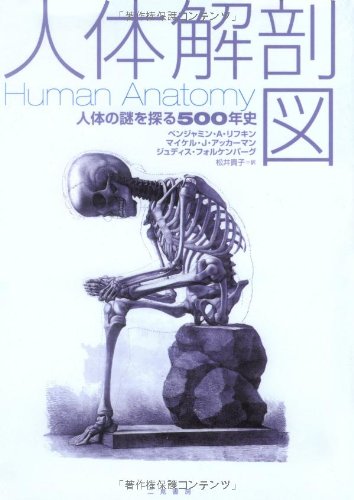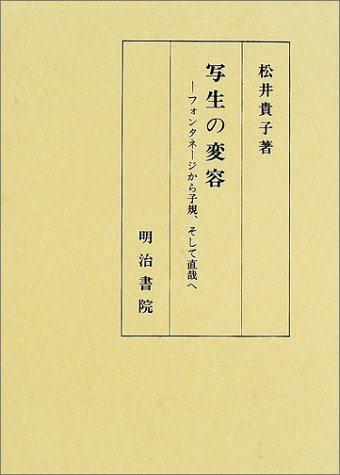2 0 0 0 IR 俳句に詠まれた那須(2)-日本の近代化と西洋化の反映-
- 著者
- 松井 貴子 Takako MATSUI
- 出版者
- 宇都宮大学国際学部
- 雑誌
- 宇都宮大学国際学部研究論集 = Journal of the Faculty of International Studies, Utsunomiya University (ISSN:13420364)
- 巻号頁・発行日
- no.51, pp.73-82, 2021-02-01
2 0 0 0 IR 俳句に詠まれた岐阜−美濃と飛騨−
- 著者
- 松井 貴子 Takako MATSUI
- 出版者
- 宇都宮大学国際学部
- 雑誌
- 宇都宮大学国際学部研究論集 = Journal of the Faculty of International Studies, Utsunomiya University (ISSN:13420364)
- 巻号頁・発行日
- no.52, pp.81-88, 2021-09-01
2 0 0 0 IR 俳句に詠まれた那須 : 日本の近代化と西洋化の反映
- 著者
- 松井 貴子
- 出版者
- 宇都宮大学国際学部
- 雑誌
- 宇都宮大学国際学部研究論集 (ISSN:13420364)
- 巻号頁・発行日
- no.50, pp.121-134, 2020-09
2 0 0 0 IR アラスカの夏の俳句(4)
- 著者
- 松井 貴子 Takako MATSUI
- 出版者
- 宇都宮大学国際学部
- 雑誌
- 宇都宮大学国際学部研究論集 (ISSN:13420364)
- 巻号頁・発行日
- no.47, pp.139-150, 2019-02
1 0 0 0 人体解剖図 : 人体の謎を探る500年史
- 著者
- ベンジャミン・A・リフキン マイケル・J・アッカーマン ジュディス・フォルケンバーグ著 松井貴子訳
- 出版者
- 二見書房
- 巻号頁・発行日
- 2007
1 0 0 0 近代「写生」の系譜:―子規とフォンタネージの絵画論
- 著者
- 松井 貴子
- 出版者
- 学術雑誌目次速報データベース由来
- 雑誌
- 比較文学 (ISSN:04408039)
- 巻号頁・発行日
- vol.39, pp.7-21,178-177, 1996
<p> Modern Japanese literature is closely related to the visual arts. This fact is especially apparent in the literary theory of the Meiji poet and essayist Masaoka Shiki (1867 -1902). Shiki's theory of <i>shasei</i> ("drawing from life"), an ideal which has exercised immense influence on modern Japanese literature, first emerged from his indirect encounter with the art theory of Italian painter Antonio Fontanesi (1818 - 1882). Arriving in Japan in 1876, Fontanesi taught painting and art theory for two years at Tokyo's Kōbu Bijutsu Gakkō. Among his students were Koyama Shōtarō (1857? 1916) and Asai Chū (1854 - 1907), two painters who in turn later were to become the teachers of Nakamura Fusetsu (1866- 1943), Shiki's friend and chief source of information about Western art theory. Through his exchanges with Fusetsu, Shiki gained an entirely new insight into literature, and a new literary vocabulary as well.</p><p> This essay makes a detailed study of the influence which Fontanesi and Western art theory had on Shiki, and how this influence is reflected in Shiki's various crtical and literary wrtings. In particular I focus on the following six points:(1) Fontanesi's reception in Meiji Japan, (2) Fontanesi's expansion of the field of subjects considered appropriate for artistic representation to encompass all phenomena, however apparently trivial or mundane, (3) Fontanesi's teachings regarding compositional principles, especially the deliberate selection of elements for representation..., (4) Making the central theme of the work stand out..., (5) Arranging individual elements into an aesthetically satisfying whole, (6) The influence of Fontanesi's ideas as reflected in Shiki's own creative work.</p><p> Shiki was able to apply the theory and vocabulary of the visual arts to his study of <i>literature</i> because he recognized the points in common to both. This insight in effect allowed him to forge a new theory of literature from the <i>art</i> theory which Fontanesi had taught, skillfully adapting the principles of the latter, primarily visual genre, to the very different problems of language and literature. Thus, Shiki's literary theory, which exerted considerable influence on later novelists as well as on tanka and haiku poets, in turn was strongly influenced by Western art theory. The emphasis that Shiki places on reinforcing literary "practice" with a well-constructed aesthetic theory —— borrowing widely across cultures and genres —— serves as evidence of his strong desire to recast native Japanese literary genres into forms viable for the modern world.</p><p> Although the influence of Western art theory on Shiki has been recognized among scholars for several decades, the exact process by which Shiki came to know of and assimilate Fontanesi's ideas has remained unexplored. This paper seeks to redress this oversight, providing a glimpse into the way Western aesthetic theory infiltrated Japanese literature and art during the Meiji period.</p>

